Pembrokeshire Boer War Memorial commemorates all of the men of the County who fell during the Anglo-Boer War of 1899 to 1902, and is located outside St. Mary’s Church in Haverfordwest. The memorial takes the form of a Celtic cross which sits on a square base, upon which are affixed marble plaques, with the names of the men of the county who fell. The memorial is not the original, this was replaced in 1896 after the existing monument had deteriorate, and also commemorates the fallen members of the Pembroke Yeomanry who fell while serving with the 30th Battalion, Imperial Yeomanry. Recent research has shown that several of these men are missing from the memorial, so I will be addressing this on the website when I have the details ready. Below is a transcription of the booklet which was published for the inauguration service of the Pembrokeshire South African War Memorial in 1908, which is of historical interest. At the base of the page I have attempted to expand on the details of the men on the memorial, with as much information as has presently come to light.
The Pembrokeshire South African War Memorial
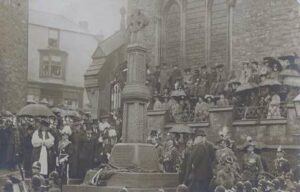
Above is a photo-postcard depicting the unveiling ceremony of the Memorial. This is one of a series of photographs which were used in the memorial booklet, a transcription of which is reproduced exactly below.
FOREWORD
As no record of the Pembrokeshire South African War Memorial has appeared, I have compiled the following account in the hope that it may prove of interest locally, and also to strangers visiting Haverfordwest.
I am indebted to Mr. W. G. Eaton Evans, Hon. Sec. of the Memorial Committee, for permission to publish extracts from its minutes ; to the Proprietors of the Haverfordwest and Milford Haven Telegraph and Pembrokeshire Herald newspapers for allowing me to reprint the passages indicated; to the late lamented editor of the Archaeologia Cambrensis (Mr. Romilly Allen, F.S.A.) for his consent to my publishing extracts from his article on “The Cross of Irbic,” in the Archaeologia Cambrensis, of July, 1904; to Mr. Thomas Lewis James, of Haverfordwest, for information as to the site of the Memorial; to the Lord Bishop of St. David’s for the words of his Prayer at its unveiling, and to the Curator of the Cardiff Museum (Mr. John Ward, F.S.A.) for permission to give a plate from a photograph of the cast of “The Cross of Irbic,” which is in the Museum.
March, 1908. THE COMPILER.
The Pembrokeshire South African War Memorial
ON the 28th of February, 1903, a public meeting, convened by Earl Cawdor, the Lord Lieutenant of the County, was held in the Shire Hall, Haverfordwest, to consider the arrangements to be made for the erection of a Memorial to Pembrokeshire men who lost their lives in active service during the South African campaign.
EARL CAWDOR said:
It had been represented to him that there was a wish that a Memorial of an appropriate kind should be erected to the memory of those Pembrokeshire men who died in South Africa during the war, either in action or from disease. He thought they would all agree with him that they could not, that day, go into the details of the matter, though, if anyone had a suggestion to make, he was sure they would be glad to hear it. He thought the best course would be to ascertain whether there was a feeling that such a Memorial was desired, and then, if that was so, to invite ladies and gentlemen to join a committee to raise subscriptions and carry out the work. They could not, of course, decide what form the Memorial should take until they knew what amount of money could be raised. They would surely have to cut their coat according to their cloth; but he thought they would have no difficulty in getting sufficient money to put up a proper and suitable Memorial to those whose good services they wished to record for posterity. . . One of those who suggested that meeting was his good friend, the High Sheriff, and as he was responsible for the meeting in the first instance, he would ask him to address them now.
The HIGH SHERIFF (Henry Owen, D.C.L. Oxon., F.S.A.), in moving a resolution affirming that it was desirable that a Memorial should be erected to Pembrokeshire men who lost their lives in the late war, said it had not been their custom to erect a Memorial to those of whom they had good reason to be proud. There was no public monument to the member of a Pembrokeshire house who fell at Waterloo, nor was there one in this town to the Elizabethan statesman who was its greatest benefactor. He was glad to see they were inaugurating a new departure. They were called upon to erect a Memorial to Pembrokeshire men who, in the good old phrase, laid down their lives for Queen and Country in South Africa. That great war had been brought to a conclusion, and he thought the consequence would be more important than any ever waged by the British Empire. It was the least they could do, and he thought also their bounden duty, to take care that the names and services of those who gave their lives for us should be recorded in some desirable Memorial. The form the Memorial should take would be a matter for future consideration, and also the place where it should be erected. If he might express an individual opinion, he would say that the proper place for a County Memorial was the County Town. He had great pleasure in moving the resolution.
The resolution was carried unanimously.
It was proposed by MR. EDWARD LAWS, F.S.A., and seconded by MR. A. W. J. STOKES, that a committee be appointed to collect subscriptions and to arrange for the erection of such Memorial, and that the following be invited to serve on the committee, with power to add to their number: -Earl Cawdor, Dr. Henry Owen, F.S.A., Sir C. E. G. Philipps, Bart., Mr. J. B, Bowen, Mr. John Worthington, Colonel M. J. Saurin, Mr. F. Lort Phillips, Mr. G. P. Brewer, the Archdeacon of St. David’s, Lady Kensington, Sir O. H. P. Scourfield, Bart., Mr. J. W. Philipps, M.P., Mr. Edward Laws, F.S,A., Colonel Meyrick, C.B., Mr. J. V. Colby, Mr. H. Seymour Allen, Colonel W. R. Roberts, Mr. Percy Arden, Mr. C. W. Rees Stokes. Mr. W. G. Eaton Evans was asked and consented to act as Hon. Secretary.
At a meeting of the Memorial Committee, held on the 18th of April, 1903, it was arranged to ask the following gentlemen to allow their names to be added to the Committee: -Lord Kensington, D.S.O., Sir Marteine Lloyd, Colonel Mirehouse, C.M.G., Mr. A. P. Saunders Davies, Captain R. V. Lloyd Philipps, M.V.O., Mr. G. D. Harries, the Mayors of the Boroughs, and the Chairmen of the several Urban District Councils in the County.
It was decided to call the Memorial “The Pembrokeshire South African War Memorial.”
At a meeting of the Memorial Committee, held on the 30th of May, 1903, the following resolution was proposed by COLONEL ROBERTS and seconded by MR. EDWARD LAWS and carried unanimously:-” That the Pembrokeshire Memorial take the form of a monument in a prominent position in Haverfordwest, and that the Town Council be asked to grant a site in one of the main thoroughfares of the town.”
It was moved by COLONEL ROBERTS and seconded by D HENRY OWEN that Dr. Griffiths be added to the Committee.
The Corporation of Haverfordwest, on being applied to, readily consented to the erection of the monument on the site of the Old Guild Hall, an open triangular piece of ground at the top of High Street, with the east end of St. Mary’s Church as the background.
The building which for many centuries occupied the site of the War Memorial was known by the several names of Guildhall, Council House, and Shire Hall. In the reign of Queen Elizabeth the Justices of the Great Sessions for the County of Pembroke began their business on the Castle Green, or outer Court of the Castle (which is in the County of Pembroke); all warrants and writs were dated at the Castle. There all judgments upon life and death were given, all fines proclaimed, and all adjournments made; but for want of a convenient Court House, the Justices were obliged to sit in the Guildhall. Some doubts seem to have arisen as to the legality of this practice, and steps were taken by the Town to remove them. The second Charter granted by James I. to Haverford empowered the Justices of Great Sessions, Sheriffs, and justices of Pembrokeshire to hold their Courts in the Guildhall of Haverford; and all acts done by them there were to have the same legal force and effect as if done within the limits of the County of Pembroke. Persons attending these Courts were exempted from the jurisdiction of the Mayor and Sheriff of Haverford. This arrangement for the use of the Guildhall came to an end on the erection, in 1835, of the present Shire Hall. The right to use the Shire Hall in the same manner as the Guildhall had theretofore been used by both counties was assured to Haverford authorities, who had expended £1,000 in providing convenient access to the Shire Hall. The Guildhall was removed to widen and improve the street, a considerable part of its site being (as above stated) utilised for the War Memorial and its enclosure.
At a meeting of the Committee, held on the 26th of September, 1903, it was resolved that a sub-committee be appointed, consisting of the following gentlemen : -Mr. Laws, Dr. Owen, Dr. Griffiths, and the Mayor of Haverfordwest (Mr. T. L. James).
The Sub-committee, at the suggestion of the late Mr. Romilly Allen, F.S.A. (editor of the Archaeologia Cambrensis), instructed Mr. Arthur G. Langdon, of Launceston, Cornwall, to draw designs, and Mr. Langdon advised that the execution of the work should be entrusted to Mr. J. Nicholls, of Launceston.
It was decided that the Cross should be a copy of the Cross of Irbic at Llandough, a village near Cardiff.
“This Cross is quite unlike most of the monuments of the same period (probably ninth century) in Wales, or indeed in any other part of Great Britain and Ireland. The architectural features of the design here assume a prominence not to be found elsewhere. When the Cross was perfect, the design must have consisted of three parts-namely, (1) the head, (2) the shaft, and (3) the pedestal. The ornament on it is of three kinds- namely, (1) interlaced work, (2) key-patterns, (3) figure subjects. The latter are confined to the four faces of the base of the pedestal of the Cross. There is nothing in the figures themselves or their grouping to give any clue to their meaning. The man on horseback on the west face is the most remarkable, and the only thing of a similar kind which occurs in Wales is on the base of the great Wheel-Cross of Conbelin, at Margam, Glamorganshire.” it has been suggested that, in each case, the horseman was intended for Christ.
I understand from Dr. Henry Owen that as the head of the Llandough Cross is missing, that of the Memorial was designed by the late Mr. Romilly Allen from what he conjectured it had been; so the Memorial, besides commemorating those who died for their country, should keep green the memory of a distinguished Pembrokeshire antiquarian. Churchmen will appreciate he fact of the base of the Memorial having been laid in its place on the Festival of St. Luke, when they remember the “great influence which he has had upon Christian art, of which, in a real sense, he may he called the founder.”
The stone of which the Cross is made comes from Polyphant, a Cornish village. The flight of steps which it surmounts are of Forest of Dean stone, the work of Mr. Harvard, monumental mason, of Haverfordwest.
The pedestal is inscribed: – On the East side
“This Memorial was raised in grateful memory of Pembrokeshire Men, who gave their lives for the Empire during the South African War, 1899-1902.”
On the North side:
WILLIAM, 5th Baron Kensington, Capt., 2nd Life Guards.
LAMBTON, A. F., Capt., 71st H.L.I.
MEYRICK, ST. JOHN, Capt., 75th G.H.
LAMBTON, R. R., Lieut., 68th D.L.I.
WHICHER, S., M.B. London, M.R.C.S., L.R.C.P.
REES, B. SKONE, Lance.-Corpl., 5th Dragoon Guards.
RICHARDS, J., Bomdr., 81st Batt. R.F.A.
SKONE. G. H., Gunner, R.G.A.
ROBINSON. S. J., Pte.. R.G.A.
GRIFFITHS, T., Pte., Grenadier Guards.
NICHOLAS, J., Pte., Grenadier Guards.
THOMAS, EVAN, Pte., Grenadier Guards.
On the West side
JONES, F. W., Pte., 2nd Scots Guards.
LEWIS, J., Corpl., 32nd D.C.L.I.
SAMBROOK, D. J., Colr,-Sergt., 41st W.R.
DAVIES, J. J., Sergt., 1st Batt, 41st W.R.
REES, W. J., Sergt., 1st V. Batt. Welsh Regt.
LOCKWOOD, E., Sergt., 2nd Batt. 51st K.O.Y.L.I.
POWELL, J., Pte., 1st Batt. Rifle Brigade.
SPAN, E. G. M., Trooper, Cape Mounted Rifles.
MORRIS, G. A., Trooper, S.A. Constabulary.
THOMAS, J., Trooper, Prince of Wales’ L.H.
JOHN, GEORGE, A.B., H.M.S. Powerful.
On the South side
Pembroke Imperial Yeomanry.
EDWARD, D. CROPPER, Col.
TIPLING, J., O.M.S.
WILLIAMS, R. P., Farr.-Sergt.
PROTHEROE, F. S., Sergt.
WILLIAMS, G., Corpl.-Farr.
JONES, S., Corpl.
Troopers.
BULLIN, L. G. HYDE, W. C. ROGERS, R. P.
CORNISH, G. JAMES, C. H. SUMMERS, A. B.
CRAPPER, A. JAMES, T. L. THOMAS, G. S.
EVANS, S. M. LEWIS, F. J. WEBB, E. R.
FRANKS, E. A. RICHARDS, E. WINSTONE, C.
The railings and dwarf wall which surround the Memorial were put up by Perrott’s Trustees, who also laid out the plot of ground on which the Memorial stands.
UNVEILING OF THE MEMORIAL.
21 OCTOBER, 1904.
Early on Friday afternoon the different contingents representing the Army commenced to assemble for the ceremony, and lined the open space on which the memorial, which was draped in a Welsh Red Dragon flag, had been erected. The representatives of the Imperial Yeomanry included: Major O. H. S. Williams, Second-Lieut. D. Davies Evans, Second-Lieut. W. G. S. Morris, Sergeant Majors Yarrow, Willmott, and 88 troopers. They were all on foot. The detachment of the 1st Shropshire Regiment from Pembroke Dock consisted of 25 privates, and the Regimental Band and buglers (under the leader ship of Bandmaster Harry Moss and Bugler-Sergeant Gray). Major Williams was in command, and the other officers present were: Colonel Dawkins, Captain and Adjutant Robinson, Major Wilkinson, and Lieut. Groves. The 1st V.B. Welsh Regiment was represented by 50 men selected from the different companies, and the following officers were present: -Captain and Adjutant Ronaldson, Major T. P. George, Captain W. J. Jones, Captain R. H. Treweeks, Lieuts. W. Marshall George, and W. Campbell Jones, Surgeon-Captain Lloyd, Chaplain Archdeacon G. C. Hilbers, and Sergeant-Major Cook (Haverfordwest). There were also present twenty men and one officer of the Royal Garrison Artillery, and ten men and a non-commissioned officer of the Royal Engineers. Among the others present in uniform were Sir O. H. P. Scourfield, Bart., Hon. Colonel of the Pembrokeshire Yeomanry, Colonel Mirehouse, Colonel W. R. Roberts and Colonel Ivor Philipps. The band took up a position in the centre of the enclosure, and whiled away the interval of waiting for the arrival of the procession by playing a selection of music. In the meantime the public had gathered in very large numbers, and every available spot from which a view of the ceremony could be obtained was occupied. The windows of all the houses in the vicinity were filled, whilst a number of persons occupied a grand stand in front of St. Mary’s church, and others were even perched on the roof of that edifice.
By three o’clock, those who were taking a leading part in the ceremony had assembled in the Council Chamber just opposite, and about that hour they emerged in the rain in procession and in the following order: -Lord Kensington; High Sheriff of the County (Mr. Owen Philipps); Bishop of St. David’s; Lord-Lieutenant of Haverfordwest (Sir Charles Philipps), Lord Cawdor, and Mr. Wynford Phillipps. M.P.: Colonel Walker (commanding Severn Defences), Baron de Rutzen; Deputy Lord-Lieutenant of the County (Dr. Henry Owen), Mayor of Haverfordwest (Mr. J. H. Bishop), Mayor of Pembroke (Mr. W. H. Griffiths); Mayor of Tenby (Mr. George Chiles), High Sheriff of Haverfordwest (Mr. T. M. Phillips), officers in uniform, Memorial Committee, aldermen and councillors of Haverfordwest. Others present included Dean Smith, of St. David’s; Dr. G. Griffiths, Chairman of the County Council; and Alderman G. P. Brewer, Archdeacon Williams, and many prominent people of the county.
After they had taken up their positions near the cross, the Lord Bishop of St. David’s offered up the following prayer:
O Almighty God, the Father of our Lord Jesus Christ Who is the Resurrection and the Life in Whom whosoever believeth shall live though he die, and whosoever liveth and believeth in Him shall not die eternally; We bless Thy holy Name for the courage and devotion of our brethren from this country, who endured the hardships of war even unto death in the service of their Sovereign and their country. Give us grace O Lord to follow their good example of seeking always the advancement of Thy Kingdom and the honour of our Sovereign, and as much as in us lies the good of our country and of all mankind.
We heartily thank Thee O Lord for that Thou hast vouchsafed to return to our country the blessings of peace, and we humbly beseech Thee of Thy great mercy to look with pity upon those nations that are now engaged in war, and to grant them peace, and we commend to Thy Fatherly goodness all those who are wounded and are in sorrow. Grant this, O Father, for Jesus Christ’s sake, our only Advocate and Mediator.-Amen.
LORD KENSINGTON then delivered a short address, in the course which he said that before asking Lord Cawdor to unveil the memorial, he would like to say a few words as to its origin. Soon after peace was declared, other places began to erect memorials, and Pembrokeshire was not far behindhand in the matter. A meeting was held, at which the Lord Lieutenant was in the chair, and it was agreed to erect a memorial. A Committee was appointed, and they had successfully carried out the work. After describing who had done the work, he said the cost had been £480, towards which £430 had been already subscribed. He was quite sure they would not be long in collecting the remaining amount. He added that the Committee thought that the cross, the emblem of the Christian religion, was a fitting memorial to those men belonging to us who died in South Africa. He asked Earl Cawdor to unveil the memorial.
COLONEL WALKER also added a few words, in the course of which he said the memorial was to men who died to build up an Imperial Country.
LORD CAWDOR then advanced to the front, and before unveiling the memorial he said he accepted with great pleasure the invitation which had been given to him. The memorial had been contributed to by all classes throughout the county- by every town and village. To many of those present no memorial was needed to bring to their minds those whose good service and sell-sacrifice were well known to them all, and the memory of whose works would ever dwell, revered and beloved, in their hearts. But it was right that we should raise this memorial, simple but good of its kind, just to remind those who came after us that it was their duty to follow in the steps of those to whom this memorial was raised-to give their service uncomplainingly wherever it might be needed, and if need be to follow the steps of those whom they were that day commemorating. They were men of every rank and class who gave their lives ungrudgingly at the country’s call and in their country’s need.
EARL CAWDOR then unveiled the memorial, the whole of the troops in the meanwhile being called to ” Atten tion.” The splendid bugle band of the Shropshires sounded the ” Salute.” The band played ‘ Hen WIad fy Nliadau,” and the buglers sounded “Last Post.” His Lordship then said it was now for him to ask Sir Charles Phiiipps, as Lord Lieutenant of Haverfordwest, and the Mayor and Corporation to take over the custody and care of this memorial. (Applause.)
SIR CHARLES PHILIPPS, in responding, said he had great pleasure, on behalf of his brother magistrates, the deputy lord lieutenants, and the inhabitants of the town and county, in conjunction with the Mayor, in accepting the sacred office which had been committed to their trust. It had been said it was a sweet and pleasant thing to die for one’s country. He believed that, but he also believed that young and noble lives, freely given for their country, by that very act showed what deeds they might have accomplished for their country had they lived. It was a great sacrifice on the part of those parents and friends who had lost some of their noblest and best, and he felt, therefore, they could not do less than commemorate the memory of such men as those, and perpetuate their names in that ancient and loyal county. It was to him a sacred office, and one he hoped long as he lived he would faithfully discharge, and he accepted on their behalf the custody of this beautiful cross, which reminded them of the great and noble fallen, and which, if the need arose, would be an incentive to others to follow in the footsteps of those they thus honoured.
THE MAYOR OF HAVERFORDWEST (Mr. J. H. Bishop) said it gave him the greatest satisfaction to be there that afternoon and take possession of that beautiful cross on behalf of the Mayor, the Corporation and burgesses of Haverfordwest. He was sure the whole county had shown its sympathy with those who had lost relatives in South Africa. At the time these young men volunteered for service this country was in great need of them, and they responded nobly to their country’s call. He hoped there would be never such another occasion, but if there was he hoped they would still have the same motto ” For King and Country.” (Applause.) In conclusion he said it would be a great pleasure to the Corporation to cherish and protect the cross. (Applause.)
The band then played the National Anthem, and the proceedings terminated.
A PILGRIM to St. David’s, arriving at Haverfordwest and making his way to the Church of St. Mary the Virgin, which he must not fail to visit, will notice in Salutation Square (name happily suggestive of the courteous people amongst whom he has come) a Memorial of the Diamond jubilee of Queen Victoria, originally intended for the refreshment of man, as well as beast.
Ascending the High Street, he will presently see the Cross which has been described in the foregoing pages, and as he does so, may, perhaps, like the writer, be reminded of Twidle’s suggestive picture, ” My grace is sufficient for thee,” a copy of which was distributed with Home Words, of January, 1906. If so, as a reproduction of “The Happy Warrior” of Watts is said to have kindled the imaginations of the soldiers at Pretoria, so may this beautiful Celtic Cross “all good thoughts stir within him.”
And yet. he may complain that a better site was not selected for the Memorial. If this be so, let him imagine that the bodies of those whose names are inscribed thereon have been brought home to rest beneath the shade of the finest Church in their County Town. Should he object that there is not sufficient contrast between the colour of the Memorial and that of the fabric in front of which it has been erected, may he remember that the thought of The Church is inextricably blended with that of The Cross.
If, whilst reasoning thus, he hears the Voice of the Cross, unveiled upon the ninety anniversary of Trafalgar Day, bidding him ever be mindful of his “Duty,” and like Dante in the Heaven of Mars, seems to see “souls in light move and pass upon the limbs of the Cross uttering divine melody and singing songs of Victory,” instead of cavilling at the site, he will rather bless the Hand which, guiding him to the Shrine of Pembrokeshire’s “Sons of the Empire,” has cut deep into his soul
“Great thoughts, grave thoughts,
Thoughts lasting to the end.”
THIS MEMORIAL
WAS RAISED
IN GRATEFUL MEMORY OF
PEMBROKESHIRE MEN
WHO GAVE THEIR LIVES
FOR THE EMPIRE
DURING THE SOUTH AFRICAN WAR
1899-1902
Some Fuller Biographies of the Men
James Beaumont Standly Alderson, Captain, 1st Battalion, Royal Irish Regiment. James was born on 1 July 1869, the son of Edward and Caroline Alderson. He had served at the Tirah from 1897-8, before moving to South Africa with his battalion. He was wounded while leading his men on the assault on Bethlehem on 7 July 1900, and died of wounds on 8 July 1900, aged 31. James is not commemorated on the County Boer War Memorial, but on a plaque in the Church at Newport, Pembs.
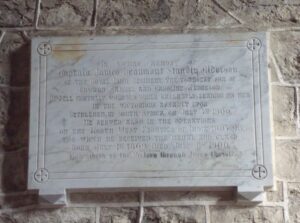
Llewellyn Gayton Bullin, Trooper, 4158, 30th (Pembrokeshire) Company, 9th Battalion, Imperial Yeomanry. Llewellyn was the son of Thomas and Mary Bullin, of Ffynon Mews, Swansea. He had suffered from periodic bouts of rheumatism as a child, but nonetheless had volunteered to serve in South Africa with the Pembroke Yeomanry. He died of heart failure on 5 November 1900 at Maitland, Capetown, aged 18. He is commemorated in Cape Town (Maitland) Cemetery, Cape Town, South Africa.
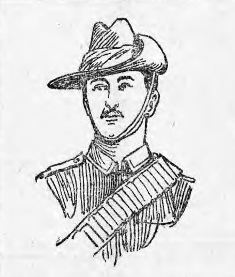
George Cornish, Trooper, 832, 30th (Pembrokeshire) Company, 9th Battalion. George was from Pontcanna, Glamorgan. He was despatched to South Africa with a number of reinforcements for the 9th Battalion, Imperial Yeomanry. He died at Heilbron of sickness on 2 July 1901.
Alfred Crapper, Trooper, 30th (Pembrokeshire) Company, 9th Battalion, Imperial Yeomanry. Alfred was the son of Evan and Margaret Crapper, of Swansea. He died of enteric fever at Norals Pont on 15 January 1902, aged 20. He is buried in Colesburg Cemetery, SA Grave No. 98. Alfred is also on the Swansea Boer War Memorial.
Edward Denman Cropper, DSO, Lieutenant Colonel, 30th (Pembrokeshire) Company, 9th Battalion, Imperial Yeomanry. Edward was the only son of Edward and Margaret Cropper, of Swaylands, Kent, and was educated at Eton. He served in the Zulu War of 1879, as orderly officer to Sir Evelyn Wood, and was present in the engagement at Ulundi, being mentioned in despatches in the London Gazette of 21 August 1879. Two years later he took part in the First Boer War as orderly officer to Sir Evelyn Wood, when he was again mentioned in despatches. He was awarded the Albert medal of the Second Class and the bronze medal of the Royal Humane Society for attempting to save a man by jumping overboard from the steamship “Idaho” on the bar off San Francisco on 6 August 1878. He obtained his commission as Captain in the Pembroke Yeomanry in June 1893, being subsequently granted the rank of Honorary Major, and since February 1900, had been a Captain in the Imperial Yeomanry, serving with the 9th (Col. Howard’s) Battalion, and was wounded by three bullets on 29 December 1900. He was advanced to the rank of Major and Honorary Lieutenant-Colonel in the Pembroke Yeomanry in January 1901. Edward was mentioned in despatches for his services during the Boer War in the London Gazette of 10 September 1901, and was granted the Distinguished Service Order, which was listed in the London Gazette of 27 September 1901, ‘In recognition of services during the operations in South Africa.’ Weakened by his wounds and service in South Africa, Edward died of pneumonia on 29 March 1901, at 29, Wimpole Street, at the age of 46. He is also commemorated on a memorial at Tabernacle Chapel, Maenclochog.
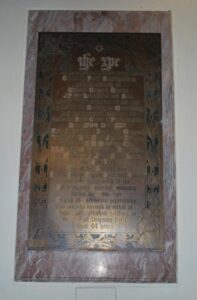
James Jenkin Davies, Sergeant, 4975, 1st Battalion, Welsh Regiment (41st Foot). James was from Hermon, near Crymych. He died of enteric fever on 11 May 1900 at Bloemfontein.
William Edwardes, Lord Kensington, Captain, 2nd Life Guards. William was born in July 1868, the eldest son of Captain William Edwardes, Fourth Baron Kensington, and of Grace Elizabeth Johnstone-Douglas, daughter of Robert Johnstone-Douglas, and was educated at Eton. He was commissioned into the 2nd Life Guards from the 7th Battalion King’s Royal Rifle Corps in June 1892, was promoted Lieutenant in April 1893, and Captain in February 1900. Lord Kensington succeeded his father in 1896, as the Fifth Baron Kensington. He was a J.P. and D.L. for Pembrokeshire and a J.P. for Haverfordwest. William was wounded at Houtnek on 30 April 1900, and died of his wounds on 24 June 1900 at Bloemfontein, aged 31. He was succeeded in the title by his brother, the Hon. Hugh Edwardes, DSO, who was a Lieutenant in the 15th Hussars.
Silas Mendelssohn Evans, Trooper, 20255, 30th (Pembrokeshire) Company, 9th Battalion, Imperial Yeomanry. Silas was the son of Silas and Annie Evans, of 21, Mansel Street, Swansea. His father was a renowned choral conductor, hence his middle name. Silas was killed in action on 20 December 1901, aged 23, during a Boer attack near Tafelkop, Frankfort District.
Edwin Albert Franks, Trooper, 30th (Pembrokeshire) Company, 9th Battalion, Imperial Yeomanry. Edwin was the son of John and Clara Franks, of 20, South Street, Bufferland, Pembroke Dock. He had served with the Imperial Yeomanry in South Africa, and returned home after the war, only to die in Pembroke Dock in the summer of 1902, aged 19, and was buried in Llanion Cemetery on 25 September 1902.
Thomas W. Griffiths, Private, 3185, 3rd Battalion, Grenadier Guards. Thomas was from Pembroke. He was killed in action at Belmont on 23 November 1899. He is buried in West End Cemetery, Kimberley.
William Clarence Hyde, Trooper, 15302, 30th (Pembrokeshire) Company, 9th Battalion, Imperial Yeomanry. William was killed in action near Hammonia on 27 December 1900. He is buried at Senekal.
William James Jacobs, Private, 5892, 1st Battalion, Royal Welsh Fusiliers. William was the son of David and Elizabeth Jacobs, of Middleway Farm, Cyffig, Whitland. He died of enteric fever at Ladysmith on 28 April 1900, aged 17. He is buried at Thornhill, Ladysmith. His brother, Arthur George Jacobs, was killed in WW1. William is not named on the Pembrokeshire Memorial but the Carmarthenshire one.
Benjamin James, Private, 829, Essex Regiment. Benjamin was the son of John and Mary James, of Mynachlogddu. Served with the 3rd Volunteer Battalion, Essex Regiment. Benjamin was taken ill and died at Bloemfontein on 1 June 1900, aged 22. He is not commemorated on the County memorial but on a fine wooden plaque at Mynachlogddu.
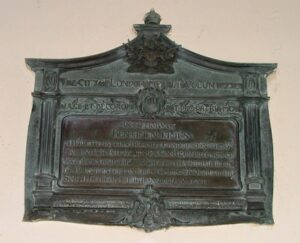
Charles Henry James, Trooper, 28739, 30th (Pembrokeshire) Company, 9th Battalion, Imperial Yeomanry. Charles died of disease at Brindsi on 19 December 1901.
Thomas Llewhellin James, Trooper, 30th (Pembrokeshire) Company, 9th Battalion, Imperial Yeomanry. Thomas was from Pembroke. He died of disease at Port Elizabeth on 8 April 1901, aged 23. He is buried in South End Cemetery, Port Elizabeth.
George John, Able Seaman, 181755, Royal Navy, HMS Powerful. George was born at Pembroke on 5 October 1877, the son of George and Mary Ann John. He enlisted into the Royal Navy on 5 October 1895, and by 8 June 1897 had been posted aboard the cruiser HMS Powerful. She was based on the China Station when the Boer War erupted, and was ordered to Durban. Upon arrival, the British forces at Ladysmith had come under siege, so the Captain of HMS Powerful, Percy Scott, ordered his men to build gun carriages, to fit naval cannon onto. A Naval Brigade from Powerful consisting of four twelve-pounders and two other guns began its epic 189 mile journey across land, with the sailors themselves having to drag the guns after their oxen died. George was wounded during the attempt to relieve Ladysmith, and died on 19 January 1900. He is also commemorated on the HMS Powerful Memorial at Plymouth. This action is commemorated by the annual Field Gun Run at the Royal Tournament.
Frederick William Jones, Private, 6610, 2nd Battalion, Scots Guards. Frederick was from Fishguard. He died of enteric fever on 27 August 1900 at Norvals Pont, which is located on the crossing of the Orange River. He was 34 years old, and is buried in Colesburg Cemetery, SA.
Samuel Jones, Corporal, 20020, 30th (Pembrokeshire) Company, 9th Battalion, Imperial Yeomanry. He died of disease at Heilbron on 26 February 1902, aged 22, and is buried in Heilbron Cemetery. He is also on the Swansea Boer War Memorial.
Alexander Frederick Lambton, Captain, 1st Battalion, Highland Light Infantry. (71st Foot). Alexander was born on 28 February 1869, the second son of Lieutenant Colonel Francis William Lambton, of Brownslade, Pembrokeshire, late Scots Guards, by his marriage with Lady Victoria Alexandrina Elizabeth, eldest daughter of John Frederick, second Earl of Cawdor. He was also grandson of William Henry Lambton, Esq., of Biddick Hall, Durham, brother of the first Earl of Durham. Alexander was educated at Wellington, and was commissioned into the Highland Light Infantry from the Royal Military College in August 1888. He was promoted Lieutenant in May 1890, and Captain in May 1896. Alexander took part in the occupation of Crete in 1898, for which he was mentioned in despatches in the London Gazette of 24 January 1899. He embarked for South Africa in October 1899 with his battalion, and joined the Kimberley Relief Force under Lieutenant-General Lord Methuen shortly before the battle of Magersfontein. Alexander was killed in action at Magersfontein on 11 December 1899. He was 30 years old, and is buried at Kimberley West End Cemetery. His brother Ronald Robert Lambton was killed with the 1st Battalion, Durham Light Infantry. Both men are also commemorated at Flimston Chapel, Castlemartin.
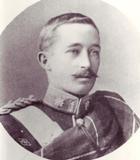
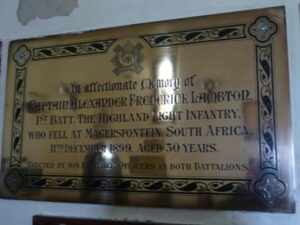
Ronald Robert Lambton, Lieutenant, 1st Battalion, Durham Light Infantry. (68th Foot). Ronald was born in March 1879, the 6th son of Lieutenant Colonel Francis William Lambton, of Brownslade, Pembroke, late Scots Guards, and of Lady Victoria Alexandrina Elizabeth, daughter of the second Earl of Cawdor. He was educated at Wellington, and was commissioned into the Durham Light Infantry from the 3rd Battalion (Duke of Cambridge’s Own) Middlesex Regiment in May 1899. Ronald was promoted Lieutenant in November 1900. He went to South Africa with his battalion in October 1899, and was present at the battle of Colenso, and the operations on the Tugela from 12 January to 6 February 1900, being severely wounded in the engagement at Vaal Kranz. He also took part in the advance through Northern Natal into the Transvaal. Ronald was wounded at Vryheid, and died of his wounds on 17 September 1901, aged 22. Ronald was mentioned in despatches by General Lord Kitchener in the London Gazette of 8 December 1901, for his ‘most gallant conduct in trying to repulse the Boer attack.’ He is buried at Vryheid. Ronald was the brother of Alexander Frederick Lambton, who is commemorated above. Both men are also commemorated on memorials at Flimston Chapel, Castlemartin.
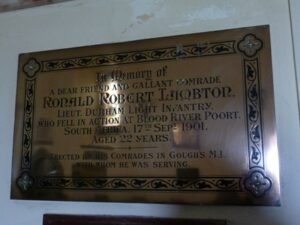
Frederick John Lewis, Trooper, 4084, 30th (Pembrokeshire) Company, 9th Battalion, Imperial Yeomanry. Frederick was the son of John and Annie Lewis, of Norchard, Manorbier. He was killed in a railway accident at Jordaan Station on 16 February 1902, aged 23.
J. Lewis, Corporal, 3061, 2nd Battalion, Duke of Cornwall’s Light Infantry (32nd Foot). Died of disease at Waterval Under on 27 January 1902, and is buried at Waterval Under.
John Edward Lockwood, Sergeant, 4358, 2nd Battalion, King’s Own Yorkshire Light Infantry (51st Foot). John was the Grandson of John and Elizabeth Davies, of 1, Assembly House, Tenby. He was killed in action at Belfast on 16 November 1900, aged 28, and is buried at Belfast.
St. John Meyrick, Captain, Gordon Highlanders (75th Foot). St. John was born on 4 August 1886, the son of Sir Thomas Charlton-Meyrick, of Apley Castle, Shropshire, and his wife, Mary Rhoda, second daughter of Col. Frederick Hill, and niece of Rowland, second Viscount Hill. [Thomas Charlton-Meyrick was the Member of Parliament for Pembrokeshire from 1868 until 1874]. St. John was educated at Cheam School, Eton, and Trinity College, Cambridge. He was gazetted into the Gordon Highlanders from the 3rd Battalion, Cheshire Regiment in December 1886, and was promoted Captain in 1897. For three years he acted as extra A.D.C., and for two years as A.D.C. to the Lord Lieutenant of Ireland. When war broke out St. John was serving at the depot at Aberdeen, but proceeded to South Africa in February 1900. He took part in the advance on Johannesburg, in the brigade under Major-Gen. Smith-Dorrien. On 30 May 1900, St. John was leading his company to attack the Boer position at Doornkop, when he was killed. The Gordons lost nearly a hundred men in their advance over the open, including St. John. He was 33 years old, and is buried in Maraisburg Cemetery, South Africa.
George Augustus Morris, Trooper, 1144, ‘B’ Division, South African Constabulary. George was the son of Reverend David Morris, and of Mary Annie Morris, of St. Ishmael’s Vicarage, Milford Haven. He was killed in action by a bullet in the eye at Zoutpans Drift on 28 November 1901, aged 21. Drift. He is also commemorated on a memorial within St. Ishmael’s Church.
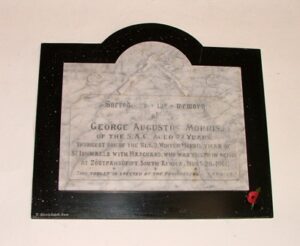
J. Nicholas, Private, 5134, 3rd Battalion, Grenadier Guards. From Crymych. Died of enteric fever on 26 April 1900 at Bloemfontein, and is buried in President Avenue Cemetery, Bloemfontein.
Joseph Powell, Rifleman, 7763, 1st Battalion, Rifle Brigade (Prince Consorts Own). Joseph was from Milford Haven. He was killed in action at Vlakfontein, Kaap River, on 9 October 1900, and is buried at Standerton.
Francis Frederick Lewes Schaw Protheroe, Sergeant Major, 4182, Imperial Yeomanry. Frank was the son of Edward Schaw Protheroe and of Ellen Augusta Cecilia Protheroe, of Dolwilym Mansion, near Whitland. He was a long serving soldier, and had fought in the Zulu War of 1877-1879. He died of enteric fever at Springfontein on 26 May 1901, aged 37. He is also commemorated on a marble panel on the right of the lych-gate of Llanglydwen Church.
Benjamin Skone Rees, Lance Corporal, 4203, 5th Dragoon Guards. Benjamin was the son of William and Annie Rees, of Haverfordwest. He had run his late father’s grocery in Market Street for several years, prior to joining the army, and embarking for South Africa. He died of enteric fever on 10 January 1900, aged 28, at Ladysmith.
William John Rees, Sergeant, 7323, 1st Volunteer Battalion, Welsh Regiment. William was born in Pembroke in 1876, and had worked for his widowed mother at the Eastgate Hotel. He enlisted into the 1st Volunteer Company, Welsh regiment on 29 January 1900, and embarked for South Africa with the regiment the following month, on 14 February 1900. He died of enteric fever at Ladysmith on 4 November 1900, aged 24, and is buried in the Town Cemetery, Ladysmith.
Evan Richards, Trooper, 15299, 30th (Pembrokeshire) Company, 9th Battalion, Imperial Yeomanry. Evan was the son of John and Mary Richards, of Betws, Glamorgan. He died of enteric fever at Cape Town on 25 May 1900.
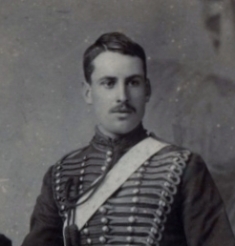
Joseph Richards, Acting Bombardier, 34112, 81st Battery, Royal Field Artillery. Joseph was from Little Haven. He died of disease at Ermelo on 7 March 1902, and is buried at Ermelo.
Sidney James Robinson, Gunner, 31636, No 2 Company, Western Division, Royal Garrison Artillery. Sidney was the son of William and Martha Robinson, of Monkton, Pembroke. He originally served with the 3rd Welsh, before enlisting into the Royal Garrison Artillery on 15 November 1898. He drowned at Ladysmith on 31 March 1900, aged 20, and is buried in the Town Cemetery, Ladysmith.
Rowland Pearson Rogers, Trooper, 30th (Pembrokeshire) Company, 9th Battalion, Imperial Yeomanry. Rowland was the son of Fletcher and Emma Maria Rogers, of Liverpool. He died of paritamitus at Lindley on 9 February 1902, aged 27.
David James Sandsbrook, Colour Sergeant, 3710, Welsh Regiment (41st Foot). David was born at Fishguard on 8 October 1871, the son of Benjamin Sambrook and Ann Sambrook (nee Rowland). He enlisted into the 41st Regiment of Foot, Welsh Regiment, as a young man. David embarked for South Africa with the 1st Battalion, Welsh Regiment. He died of wounds received at the Battle of Driefontein on 10 March 1900, reportedly after being shot by Boer’s carrying a flag of truce. There is a memorial to him in the Churchyard of St. Mary’s Church, Fishguard. (His surname can be found spelt in several ways in varying sources: Sambrook, Sambruck, Sandbrook, and Sandsbrook, which is the name he served under).
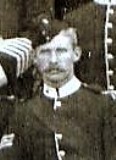
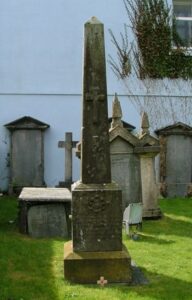
George Henry Skone, Gunner, 65842, No 6 Company, Western Division, Royal Garrison Artillery. George was the son of John and Esther Skone, of Pembroke. He died of enteric fever at Ladysmith on 13 May 1900, aged 34. His widow, Selina Skone (nee Colley) died soon afterwards.
Edmund George Mitchell Span, Trooper, 3161, Cape Mounted Rifles. Edmund was born in India in 1877, the son of Bartlet and Alice Eliza Span (nee Jebb). His father had worked for the East India Company before retiring to The Woodlands, Tenby. Edmund was living in South Africa at the start of the Boer War, and served with the Cape Mounted Rifles. He was killed at Labuschagnes Nek on 4 March 1900, aged 23. His younger brother, Frederick Herbert Span, was taken prisoner by the Germans in 1914, and another brother, Henry John Bartlet Span, was awarded the Distinguished Service Order with the 1st Welsh in Salonika in 1918. He is also commemorated on a memorial inside Gumfreston Church.
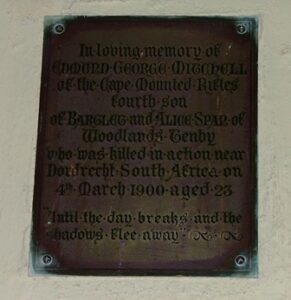
Arthur Bowlas Summers, Lance Corporal, 4113, 30th (Pembrokeshire) Company, 9th Battalion, Imperial Yeomanry. Arthur was the son of James and Emma Summers, of Rosemoor, Little Haven. He died of disease at Winburg on 11 October 1900, aged 32, and is buried in Jac Coetzer Street Cemetery, Winburg.
Evan Thomas, Private 4973, 2nd Battalion, Grenadier Guards. Evan was the son of Philip and Mary Thomas, of Tyrhyg, Ambleston. He died of enteric fever at Standerton on 4 April 1901, aged 22, and is buried at Standerton.
Stanley Graham Thomas, Trooper, 4159, 30th (Pembrokeshire) Company, 9th Battalion, Imperial Yeomanry. Stanley was the son of Robert and Jane Thomas, of Swansea. He was living at Haverfordwest prior to enlisting into the Pembroke Yeomanry. He was killed in action during the Boer attack on Fauresmith on 19 October 1900, aged 25.
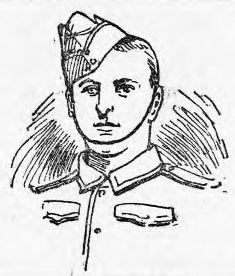
Joseph Thomas, Trooper, 27013, Prince of Wales Light Horse. Joseph was from Goodwick. He was wounded on 12 June 1901, and died of his wounds on 13 June 1901 at Wonderkop.
Herbert John Tipling, Quartermaster Sergeant, 4164, 30th (Pembrokeshire) Company, 9th Battalion, Imperial Yeomanry. Herbert had worked at Ben Evans and Son Department Store at Swansea, prior to embarking for South Africa with the Pembroke Yeomanry. He died of enteric fever at Heilbron on 17 April 1900, aged 25, and is buried In the Town Cemetery, Heilbron.
Ernest Robert Webb, Trooper, 23361, 30th (Pembrokeshire) Company, 9th Battalion, Imperial Yeomanry. Ernest was from Chepstow. He died of enteric fever at Harrismith on 29 May 1901, aged 21.
Stanley Whicher, M.B. London M.R.C.S. L.R.C.P., Civil Surgeon, Royal Army Medical Corps. Stanley was the son of Joseph and Susan Whicher, of Milford Haven. He had been educated at Haverfordwest Grammar School and at the University of Wales, Aberystwyth, before qualifying as a Doctor at Guy’s Hospital, London. He embarked for South Africa in November 1899 to work as a Civil Surgeon, and died of enteric at Mooi River on 27 April 1900, aged 29.
George Henry Williams, Corporal Farrier, 26645, 30th (Pembrokeshire) Company, 9th Battalion, Imperial Yeomanry. George was the son of James and Mary Jane Williams, of Neyland. He died of disease at Aliwal North on 5 June 1901, aged 29.
Ralph Paynter Williams, Farrier Sergeant 4138, 30th (Pembrokeshire) Company, 9th Battalion, Imperial Yeomanry. Ralph was born at Pembroke on 13 December 1879, the son of Reverend David Edward Williams, and Mrs Rose Williams (nee Paynter), of Lampeter Velfrey. He was educated at Haileybury, Hertfordshire and Royal Veterinary College. He then joined the Royal Army Veterinary Corps, but at the outbreak of the Boer War, volunteered for service with the Pembroke Yeomanry. He was killed in action near Ventersburg while attempting to rescue an officer on 23 August 1900, aged 21, and is buried in Ventersburg Cemetery,Ventersburg. He is commemorated on a stained glass window and on a memorial at Lampeter Velfrey Church.

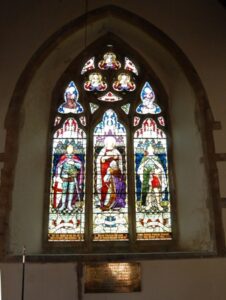
Cornelius Winstone, Trooper, 30511, 30th (Pembrokeshire) Company, 9th Battalion, Imperial Yeomanry. Cornelius was the son of Cornelius and Elizabeth Winstone, of Llangyfelach, Swansea. He died of disease at Heilbron on 9 February 1902, aged 20, and is buried in the Town Cemetery, Heilbron.